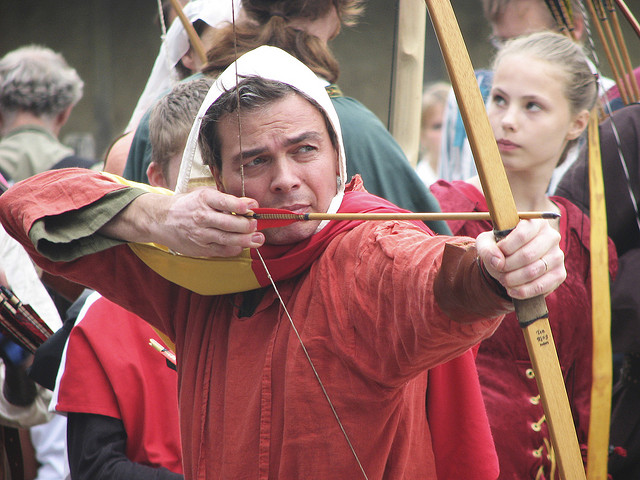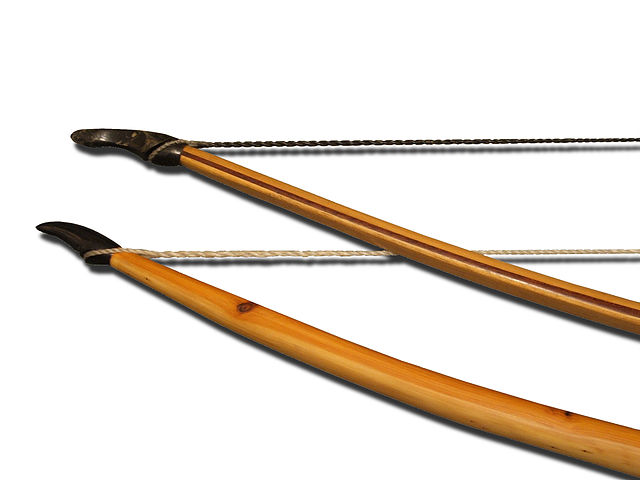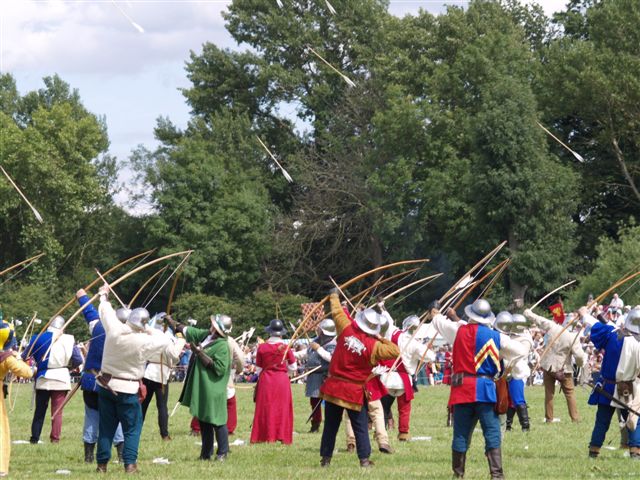My reviews are based on my experience and thorough research. When you make a purchase using my links, I may earn a commission. Learn more
You have read a lot about modern bows like recurve bows or compound bows on my website.
Now, let’s take a closer look at traditional archery bows for a change.
What types of traditional bows are there?
Where did they come from?
Is anybody still using them?
Keep reading to find out:
Types Of Traditional Archery Bows
I want to talk about the following three bow types and a bit about their history, specialities and attributes:
- English Longbow
- Japanese Yumi
- Asian Composite Bows
Things They All Share
Before I tell you in detail what these bows are about, there are some things they all have in common.
Traditional bows don’t have any attachements that makes the archers life easier, like modern bows do.
There are no sights, arrow rests, stabilizers, etc.
It is just the bow and the archer.
It is archery in its purest form and for that I am a big fan of the longbow. While I like shooting my recurve bow, I still do love my longbow more.
Another thing they share is that they are made of natural materials. There is no metal, plastic, etc. involved in making traditional bows, which makes sense as those materials were not available when the bows were invented.
A Look At The Famous English Longbow
If you are only a bit interested in the medieval times, then you will have heard a lot about this bow.
English archers were famous and feared for their skill with the longbow, which is sometimes also called Welsh longbow.
Even when the stronger crossbows were invented, English archers could still outshoot them, because bows are much faster to reload than any crossbow and they had an incredible range.
Quick facts about the English longbow 
- about 6 ft (1.80m) long
- made of one piece of wood
- draw weights up to 185 LBS
- range up to 400yd (370m)
The magic of the English longbow
While there were shorter and longer English longbows, most were about 6 feet long. This is really long compared to recurve bows or compound bows.
Imagine you are handling a bow that is as long (or even longer) than you are tall!
I think it is fantastic and my longbow is actually almost as long as I am tall (I am 6 ft 1 in, 1.84m).
But they were not only very long, but incredibly strong!
Their draw weight could be up to 185 LBS which most people nowadays would be incapable of pulling back. If someone draws a bow with 50 LBS then this is already a lot.
Modern bows are usually not stronger than 50-80 LBS (most are much weaker than that; 30-50 LBS).
You could get a compound bow with 100 LBS if you ask the manufacturer, but most people wouldn’t be able to draw and hold it. You would most likely just hurt yourself!
This means that English archers had to be trained from early on and the rest of their lives to handle the longbow.
While they could shoot up to 400 yards (370 meters), they had to be accurate on a distance of 220 yards (200m) with lighter arrows.
On shorter distances they would use heavier arrows, that would hit harder on impact which were used in battles.
Compared to today, the range they had to be accurate at is insane!
Archery competitions don’t exceed 100 yards (91 meters) and are often even less than that.
At the Olympic Games the distance is 70 meters (76 yards).
How to make a longbow
Longbows are relatively easy to craft, but to get a real good one, you should go to a professional bow maker.
Traditionally they are made of one long piece of wood like yew, ash or elm.
Other woods can be used, too.
Even though it is only a single piece of wood, it could still take quite a while before a bow was finished. In the medieval times, bow makers would let the wood dry for 1-2 years and then work it into shape slowly.
This could take up to 4 years in total!
Modern bow makers have changed their techniques and bring the bow down into its shape while it is still wet and dry it afterwards.
The thinner wood will dry much quicker then.
A bow is nothing without its string, which was made of hemp, flax or silk.
Many bow makers who craft traditional archery bows still use these materials to make a bow string, but modern longbows might feature a “dacron” string, too.
The English Longbow In Battle
As I mentioned, English archers were feared in battle and even knights in heavy armor were not 100% safe from their arrows.
This is because they had very different types of arrowheads.
Lightly armored enemies could be taken out by normal broadheads, which archers mostly used in battles and sieges.
But they had a special surprise for armored foes, the bodkin arrowhead. This arrowhead was especially made to pierce through metal and still have enough power to hurt or kill the owner of that armor.
So, if not stopped by a shield, the arrows of English longbow archers would become the nightmare of every fighting man in the field.
Because of their long range, archers would be either placed behind the battlements of a wall, or behind the other fighting men on a field to give them as much protection as possible.
They would also shoot not more than 6 arrows every minute to not exhaust themselves too quickly. (Remember the incredible draw weight of those bows.)
Their biggest weakness would be the melee combat, as the bow would only hinder them. They would drop their bows and fight with swords, but seasoned sword fighters or riders would be able to take them out easily when they were able to reach them, as archers were mostly trained in handling the bow.
Coming Up
In my following two articles I will talk about the Yumi and composite bows.
Both are fascinating and very different to the English longbow.
I hope you like my series about traditional archery bows.
If you have any question about the English longbow, let me know below in the comments.
What is your favorite bow type?
Are you a traditional or modern archer?
Let’s discuss!
Yours,
Moritz




